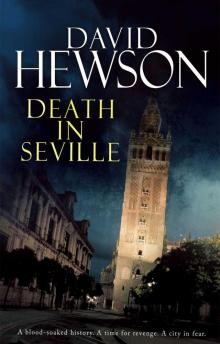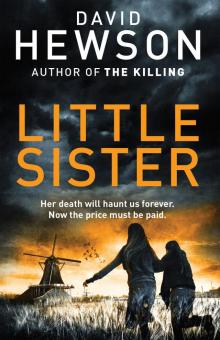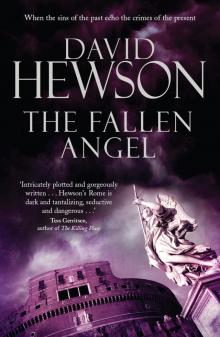- Home
- David Hewson
The Seventh Sacrament Page 6
The Seventh Sacrament Read online
Page 6
For some reason these thoughts haunted Gabrielli more than usual as the warden sipped his coffee and picked at the pastry. He knew why, too. It was the man next door, wrapped up tight in his coat and hat and scarf, yet—and Gabrielli knew this was ridiculous—familiar somehow. There was also his eagerness to be in that confounded room. The visitor hadn’t even asked a single question, it now occurred to him, except: Is it still there?
It was almost as if he’d been here before, and that was another thought that Gabrielli found disturbing.
Reluctantly—a part of him was coming to hate that little room—he got up and, with all the speed a sixty-seven-year-old man could muster, crossed the passage and stood by the door to the familiar place. The too-bright lights of the passageway dazzled him. At first he fooled himself that the visitor was gone, without a word of thanks or so much as a departing footstep. There wasn’t a human sound from anywhere, save for his own laboured breathing, the gift of a lifetime’s addiction to strong cigarettes. All Pino Gabrielli could hear was the repetitive, mechanical roar of the traffic, a constant tide of sound so familiar and predictable he rarely noticed it, though today it seemed louder than ever, seemed to enter his head and rebound inside his rising imagination.
Then he stepped into the narrow, claustrophobic room, knowing as he did so that he entered a place that was wrong, out of kilter with the world he liked to inhabit.
He didn’t believe in Purgatory. Not really. But at that moment, with his heart beating a compound rhythm deep beneath his tight waistcoat, his throat dry with fear, Pino Gabrielli was aware that even a man like him, a former professor of architecture, well read, well travelled, with an open, inquisitive mind, sometimes knew very little at all.
The figure in black was busy in the pool of hard shadow at the far wall where Alessio Bramante’s T-shirt was kept. The item was no longer in its case but pinned to the old pale plaster by the intruder’s left hand. His right fist held some kind of grubby cloth, dripping with a dark viscous liquid. Gabrielli watched, unable to move, as the man stabbed at the boy’s shirt four times, enlarging each old stain with a new one that was bright and shiny with fresh blood. Finally he added an extra mark, a thick, sanguineous blotch on a previously unblemished star to the upper left.
One more message, the petrified warden thought, to add to four that had already gone unheard.
Perhaps Gabrielli uttered some noise. Perhaps it was simply his labored breathing. He became aware that his presence was known. The man placed the shirt back in its case with slow, ponderous care, and pushed the glass back into position, leaving gory, sticky marks on the surface. Then he dragged off his heavy woollen hat and turned round.
“You…” Gabrielli murmured, astonished by what he saw.
Pino Gabrielli closed his eyes, felt his bladder go weak, his mind go blank, ashamed that, in extremis, he found it impossible to pray.
WHEN HE RECOVERED the courage to look around him again, he was alone. Gabrielli stumbled to the nave and fell into a hard wooden pew there, trembling.
Sacro Cuore was dear to him. He knew the rules, the protocols that bound its governance, and that of any church in Rome. By rights he should have called the priest and members of the parochial council before anyone. Just as he had done before.
And still the messages kept coming, this time with the messenger.
Enough was enough. With a shaking hand, Pino Gabrielli withdrew his phone from his pocket, waited for his fingers to stop shaking, wondering whom to dial in such circumstances—112 for the Carabinieri? Or 113 for the police? There was no easy number for God. That was why men built churches in the first place.
He tried not to think about the face of the man he’d seen. Someone he had once known, almost to the point of friendship. Someone who now had cold black eyes and skin that had the dry, desiccated pallor of a corpse.
The Carabinieri were more Gabrielli’s kind. Middle-class. Well dressed. Polite. More sophisticated.
Only half understanding why, he wandered back into the little room as he struggled with his phone, smelling the blood, dimly aware there was something else, something he should have seen. His shuddering finger fought for the buttons, fell all over the place and got the wrong ones anyway. Perhaps, he thought, it was just fate. Most things were.
Too late, he heard a hard female voice on the line, demanding an answer.
Pino Gabrielli looked at the Little Museum of Purgatory, properly this time, not fearful for his life because of some dark familiar stranger who stank of blood.
His intuition had been right. There was something new. A direct message, written in a way he’d never forget.
It was a moment before Gabrielli could speak. And when he did, only a single word escaped his lips.
“Bramante…” he murmured, unable to take his eyes off the line of bloody writing on the wall, a crooked, continuous script, with deliberate lettering, the handiwork of someone or something determined to make a point, in just a few words.
Ca’ d’Ossi.
The House of Bones.
PINO GABRIELLI WASN’T THE ONLY CHURCH WARDEN IN Rome to receive a surprise that morning. Half an hour after Pino opened the doors of the small white church in Prati, Ornella Di Benedetto found herself facing the padlocked chains on the shuttered, abandoned wreck that was once Santa Maria dell’Assunta, wondering what looked different. The logical answer—that someone had gone inside—seemed too absurd for words.
Rome had many churches. Too many to cater to a population that grew more secular by the year. Santa Maria dell’Assunta, set on the southeastern side of the Aventino hill, not far from the Piazza Albania, had little to keep it in business. The historians said it stood on the site of one of the oldest churches in Rome, dating back to the earliest times, when Christianity was one religion among many, sometimes persecuted, sometimes tolerated, occasionally encouraged. Not a trace remained of the original church. Over the centuries, it had been rebuilt on at least five occasions, burned to the ground more than once, then, in the sixteenth century, handed over to an order of Capuchin monks. The tiny, unremarkable building that survived lasted a further three centuries as a consecrated property, then, under Napoleon’s anti-clerical hand, fell into disuse, and was later converted into municipal offices. At the beginning of the twentieth century, it became, briefly, a private residence occupied by an elderly British writer of arcane and macabre tastes. After his death it slid steadily into ruin, maintained only by a small grant from the city and a local diocese still somewhat guilty over its abandonment. The mishmash of architectural styles and the absence of a single important painting or sculpture meant that the middle-aged woman who kept an eye on the place was, for months on end, the only person to set foot beyond its dusty, rotting oak doors, in the narrow cul-de-sac just a few metres from the bustle of the Viale Aventino.
Even so, Santa Maria dell’Assunta had one esoteric feature, hidden away in a crypt reachable only through a narrow, damp, and winding corridor cut into the hill’s soft rock. The same Capuchin monks who had maintained the church for a while continued to own a greater property in Rome, Santa Maria della Concezione in the Via Veneto, just a little way up from the American Embassy. Here they had created a curiosity too: a crypt much larger than that of Santa Maria dell’Assunta, decorated—there was no other way to put it—with the bones of some four thousand of their fellows, deposited there until the late nineteenth century, when the practice was deemed a little too grisly for modern tastes.
Ornella Di Benedetto knew that place well and had compared it in detail with the one in her own charge, hoping one day to be able to impress visitors with her erudition. The charnel house in the Via Veneto was undoubtedly impressive. She wished her own dead monks had provided a similar quotable motto for the inscription over their tomb on the Aventino.
Quello che voi siete noi eravamo, quello che noi siamo voi sarete, read the famous epitaph.
What you are we were, what we are you will be.
But her smaller vers
ion was, Ornella felt, more tasteful, more in keeping with the original purpose. It had none of the theatrical touches of Concezione: skeletons still in their monastic robes, cowls drawn around their skulls, patterns of vertebrae and jawbones arranged like some ghastly frieze, mocking the spectator, seeming, to her, to deny that anything of value existed in their worldly lives.
Santa Maria dell’Assunta was, simply, an underground public tomb, a place where a hundred monks—no more, no less—decided that their remains should stay visible for anyone who wished to see them. After a suitable time in the Capuchin cemetery in San Giovanni—she had researched this thoroughly for her imaginary visitors—they would be exhumed and taken to the crypt. There each corpse was arrayed tidily on the bare earth, five rows, twenty in each, skeletal arms neatly folded over skeletal chests, patiently awaiting resurrection.
The late English writer had installed some weak electrical lighting so that his visitors could enjoy the spectacle. Rumour had it that his will had demanded he be laid among them, too, an idea the city authorities quashed on health grounds, though only when he was in no condition to object. The man had lived in Venice for several years, in a small palazzo adjoining the Ca’ d’Oro on the Grand Canal, before moving to Rome. That had, apparently, been his inspiration for giving the place the nickname by which it continued to be known in the neighbourhood: Ca’ d’Ossi. Not that “the House of Bones” was a sobriquet Ornella would ever use.
The Capuchins of Santa Maria dell’Assunta had, she firmly believed, bequeathed to future generations a humane and instructive exhibition, with none of the tourist-seeking histrionics of the larger place on the Via Veneto. It deserved to be better known, and perhaps receive a little restoration money, some of which would, naturally, find its way into the pocket of its lone custodian over the years.
Nor—and she’d had to explain this point repeatedly to friends and relatives—had Santa Maria dell’Assunta ever scared her. Death, for Ornella Di Benedetto, was an ordinary, unremarkable figure who walked through the world like everyone else, trying to get on with the job Fate had given him. Some days, she imagined, he would hop onto the Number 3 tram that ran through Testaccio across the river to Trastevere, and back into the city in the opposite direction, studying the faces of his fellow travellers, trying to decide which among them was deserving of another journey altogether. Then, when his work was done, he would sit by the Tiber for a while, letting the traffic roar drown out his thoughts.
Ornella Di Benedetto was never in fear of the corpses in her care, which made it all the more inexplicable that she was reluctant to enter the church that morning. The padlock and chain had been broken. It had happened before, a long time ago. Some youngsters had entered the building, looking for somewhere to sleep, something to steal. They would be disappointed on both counts. The place was cold and fusty, populated by rats, for which she left poison. Not an item of value remained, not even decent furniture. In the small nave, which the Englishman had used as a general hall and dining room, only a few worthless pews and a shattered pulpit still stood.
Another time, twenty years ago, a drunk had found his way into the cellar, turned on the lights, then run out into the street screaming. That amused her. It had been exactly what the idiot deserved.
No serious criminal would give Santa Maria dell’Assunta a second look. No thrill-seeking teenager could possibly think it was worth breaking into; there were much more atmospheric underground caverns scattered throughout Rome if that was what they wanted.
Still, she hesitated there for a good two minutes, the bag with fresh rat poison in it hanging on her arm. It was absurd.
With a brief curse at her own timidity, Ornella Di Benedetto threw the shattered chain and padlock out of the way, mentally making a note that she would have to charge someone, city or diocese, for a replacement, and pulled open the oak door.
THE LIGHTS WERE STILL ON IN THE INTERNAL PORTICO. She turned them off, then walked into the diminutive nave, where a thin winter sun was streaming through the cracked stained glass on the western end of the building.
To her dismay, the door to the crypt was open. There was a light in there, too, the familiar weak yellow haze creeping up from the underground cavern.
The sight made her furious. She hated waste. Electricity was more expensive than ever.
She walked to the door and reached for the switch, averting her gaze from the corridor, not through fear but practicality. She needed to try to understand what had happened. To work out whether it was worth calling the police.
It was possible, just, that someone was still down there, hidden with her familiar skeletons, up to no good. That thought hadn’t occurred to her until her fingers touched the old damp powdery plaster of the corridor wall.
But why would anyone break into an empty, deconsecrated church for anything but some idiotic amusement? It was ridiculous, she reminded herself, but then became aware of the smell, elusive at first, but soon familiar. It was the smell of the market in Testaccio, the local one off Mastro Giorgio, where every morning she bought the day’s food: salad and vegetables, and a little meat from one of the many stalls with their vivid red displays of pork and beef, chickens and lamb. Even, in one seldom-visited corner, horse, which only the old people ate these days.
So she didn’t turn off the lights. Something about the smell made that impossible. Instead, Ornella Di Benedetto took three steps down the narrow, worn stone stairs, just far enough to see into the crypt, with its serried rows of grey, tidy bones.
And something else among them, too. Something gleaming under the bulbs, a half-familiar shape transformed somehow, metamorphosed into the source of that rank, permeating stench that wouldn’t quit her nostrils.
When she finally reached the street, babbling like a madwoman, trying to catch the attention of passersby who ignored her shrieking implications, she’d no idea how long she’d spent in that place, or what, in truth, she’d done there.
They stared at her. All of them. Every shopper in the market. Every stallholder. Everyone.
I am not insane, Ornella wanted to scream at them. I am not!
Even though she couldn’t recall how she had made her way from the Piazza Albania into Testaccio in order to find the market, or how long it had taken. An hour at least, or so it seemed from the market clock, which now stood at five past eleven. Somewhere along the way, she thought, she’d sat down and passed out for a while, like some neighbourhood drunk, stunned by cheap grappa.
Her eyes worked their way across the hall, to the lines of butchers’ stalls where the meat hung fresh and livid on the hook, scarlet flesh, waxy white fat, veins and organs, limbs and carcasses, entrails and the occasional small pig’s head.
Since she was a child, this market had been a place of delight. The aroma of flowers mingled with the fresh salt tang of the fish stalls. Oranges from Sicily next to stands selling fresh white buffalo mozzarella at prices even ordinary people could afford.
She’d never really thought about the meat stalls until then, when the sight and the stench of the crypt came back to her. Ornella Di Benedetto turned her head away from the butchers’ stands, tried to stop the fleshy, organic stink of them creeping into her mouth and nostrils, breathed deeply once, gasping down a lungful of the market’s now vile and rotting aroma, wondering whether she was about to be sick.
It was an unconscionable time before anyone listened, and that was the closest human being she could think of who knew her: the kindly young girl in the market’s vegetable stall. She listened to Ornella’s ragged, incoherent story, then sat her down with a stiff caffè corretto before calling the police.
When Ornetta looked up, still desperately queasy, she found a dark-skinned woman staring thoughtfully into her face, her eyes full of concern and curiosity.
“My name is Rosa Prabakaran,” the woman said. “I’m a police officer.”
“The church…” she murmured, wondering where to begin.
The young policewoman nodded, confidently,
in a way that made Ornella Di Benedetto feel a little better.
“We know, signora,” she said, glancing around the hall, not looking too hard at the meat stands either. “I just came from there. Shall we go somewhere else? Now? Please?”
IT HAD BEEN A GOOD WINTER, THE BEST NIC COSTA COULD remember in years. There were just two cases left of the vino novello they’d made the previous autumn. Costa was surprised to find that the modest homegrown vintage, the first the little estate had produced since the death of his father, met with Leo Falcone’s approval too. Either the wine was good or the old inspector was mellowing as he adjusted to an unaccustomed frailty.
Or both. The world was, Costa had come to realise over the past few months, occasionally ripe with surprises.
That lunchtime they’d taken a few bottles over to the new home Falcone was sharing with Raffaella Arcangelo, a ground-floor apartment in a quiet backstreet in Monti, rented on a temporary basis until the inspector became more mobile. The injuries Falcone had suffered the previous summer were slow to heal, and he was slow to adapt to them. The meal was, they knew without saying, a kind of staging point for them all—Costa and Emily Deacon, Gianni Peroni and the pathologist Teresa Lupo, Leo Falcone and Raffaella—a way of setting the past aside and fixing some kind of firm commitment for the future.
The previous twelve months had been hard and decisive. Their last investigation as a team, exiled to Venice, had almost resulted in Falcone’s death. Nic’s partner Peroni and Teresa had emerged unscathed, perhaps stronger than ever once the dust settled. While Teresa returned to the police morgue, Peroni became a plainclothes agente again, walking the streets of Rome, on this occasion in charge of a new recruit, a woman who, as the ugly cop was only too keen to tell anyone in earshot, drove him to distraction with her boundless enthusiasm and naïveté.
Costa had pulled the best prize of all out of the bag: a winter spent organising security for a vast art exhibition set around the works of Caravaggio, one that had played to full audiences in the Palazzo Ruspoli from its opening in November to its much-mourned closure two weeks before. There had been some last work to be done, most important of all a final round of security meetings for the return shipping of exhibits, and one long trip to London to liaise with the National Gallery. Then finally, two days before, nothing. No meetings. No deadlines. No phone calls. Only the realisation that this extraordinary period of his life, one which had opened up so many new avenues, was now over. After a week’s holiday he, too, would be back on the job, an agente working the centro storico of Rome, uncertain of his future. No one had told him if he’d be reunited with Peroni. No one had hinted when Falcone might be back in harness. Only one piece of advice had been handed down to Costa from on high by Commissario Messina. It was time, Messina said one evening on his way out, for a man of Costa’s age to start thinking about his future. The exams for promotion were being scheduled. Soon, Nic ought to consider trying to take one step up the ladder, from agente to sovrintendente.

 The Garden of Angels
The Garden of Angels Solstice
Solstice Death in Seville
Death in Seville A Season for the Dead
A Season for the Dead The Killing tk-1
The Killing tk-1 The Savage Shore
The Savage Shore Dante's Numbers
Dante's Numbers Sacred Cut
Sacred Cut City of Fear nc-8
City of Fear nc-8 The Blue Demon
The Blue Demon The Garden of Evil
The Garden of Evil The Lizard's Bite
The Lizard's Bite The Wrong Girl
The Wrong Girl Sleep Baby Sleep
Sleep Baby Sleep Lucifer's Shadow
Lucifer's Shadow Season for the Dead
Season for the Dead The Seventh Sacrament
The Seventh Sacrament The Garden of Evil nc-6
The Garden of Evil nc-6 Juliet & Romeo
Juliet & Romeo A Season for the Dead nc-1
A Season for the Dead nc-1 The Fallen Angel nc-9
The Fallen Angel nc-9 Little Sister
Little Sister The Lizard's Bite nc-4
The Lizard's Bite nc-4 The Killing 2
The Killing 2 The Fallen Angel
The Fallen Angel The Sacred Cut
The Sacred Cut Carnival for the Dead
Carnival for the Dead The Villa of Mysteries nc-2
The Villa of Mysteries nc-2 Macbeth
Macbeth The Killing - 01 - The Killing
The Killing - 01 - The Killing The Villa of Mysteries
The Villa of Mysteries Dante's Numbers nc-7
Dante's Numbers nc-7 The Sacred Cut nc-3
The Sacred Cut nc-3 The Seventh Sacrament nc-5
The Seventh Sacrament nc-5